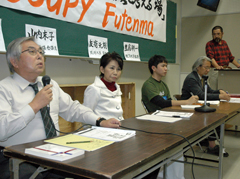Citizen group discusses methods of resistance on the Futenma gate blockade action

On December 8, at Okinawa International University in Ginowan, members of citizen groups discussed how peace movements should be in future.
December 9, 2012 Ryukyu Shimpo
On December 8, at Okinawa International University in Ginowan members of the citizens’ group “Occupy Futenma” held a symposium entitled “Thinking about the September 30 Futenma Air Station gate blockade action.” Looking back at the protest action carried out almost three months ago against the Osprey deployment, members of the group who were actually there and participants on the floor discussed what the nature of the peace movement should be as it moves forward. Some new approaches were suggested, including working together with people involved in the anti-nuclear power movement.
Pointing out the current situation in which the movement to amend the constitution has come out into the open, Hiroji Yamashiro, the secretary-general of the Okinawa Peace Movement Center, stated, “What we managed to do at Futenma is highly significant.” He also touched on the issue of nuclear power, saying, “Our voices should continue to be heard from Okinawa. I think that we can join forces with other victims of government bullying.” Peace activist Yamashiro called for the movement to display a dignified attitude and have strong ambitions, saying, “The Okinawan movement has given hope to people all across the country.”
With regard to the incident that occurred in front of the gate of the Futenma Air Station on September 30 in which the police removed protesting citizens from the scene to stop the blockade, lawyer Shunji Miyake commented, “There is no legal basis for the police using their authority to remove citizens.” Sueko Yamauchi, the member of the Okinawa Prefectural Assembly who pursued this issue at a regular meeting of the Assembly, reported on the interaction between her and Okinawa police chief Takashi Murata. Motoki Tomoyose, a student of the University of the Ryukyus, explained the event called “Night Picnic” that student groups held in the square near Oyama Gate to protest against the rape of a local woman by U.S. sailors. They used a new form of resistance in which participants exchanged views under candlelight, deciding against using banners or shouting out in chorus.
(English translation by T&CT, Mark Ealey)
Previous Article:Movie featuring the U.S. military aircraft crash onto Miyamori Elementary School screened
Next Article:Afforestation project for Shuri Castle starts in Higashi-son
[Similar Articles]
- Stand off between citizens and police officers at gate of Camp Schwab in Nago
- 1,000 people gather in front of Camp Schwab gate to celebrate 500 days of sit-in
- Sit-in protest in front of Camp Schwab marks 150 days and 18,000 participants
- Protest in front of Naha District Court to demand release of Hiroji Yamashiro prior to submission of petition signed by 29,000
- Citizen group sit-in block gates to U.S. Futenma base
 Webcam(Kokusai Street)
Webcam(Kokusai Street)


